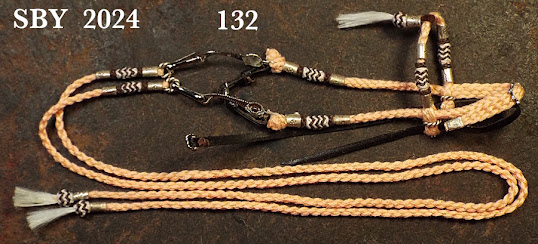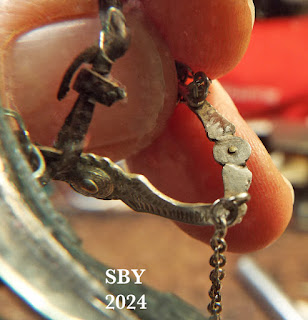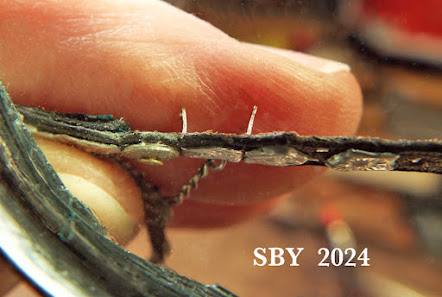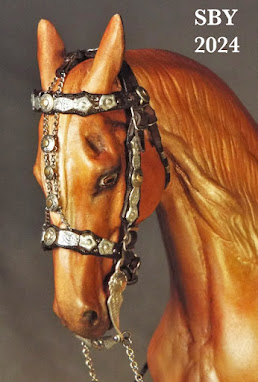This post celebrates both the April 2 Hackamore and the original it was copied from, and then tells what will happen to it, viz, when, where and how it can be got! April's Hackamore is the 5th of the 8 pieces in my next book, so we really are past the half-way point. I am finally seeing light at the end of this two-year tunnel, because the 6th is Fancy's, and that one's already largely covered due to being blogged about so much back in 2015. And after that, only two to go!! d'ya hear me Fall??
Naturally, a black-blue-&-white hackamore had to be photo'd on a black-blue-&-white horse. I really like this shot even though it shows the horse and not the tack. Something about the proportions came out right,... usually my camera exaggerates the muzzle in this pose.
For purposes of the book, I'm calling the copies of the pieces made for it by numbered names: 'Mala 2,' 'April 2' and 'Peach Rose 2.' This was a convenient way to distinguish between the original and what I was documenting building. This numbering is doomed to be temporary, for once the book is published and people start building their own copies, the count is lost and the numbers revert to each tackmaker's personal oeuvre.
When it comes to Fancy's Hackamore, things get embarrassing because two other copies were built alongside the original back in 2005; and when I replaced Fancy's in 2015, another copy, the fifth, was made! So technically the one being built for the book would thus be Fancy 6. However, for purposes of simplicity and continuity, I'm going to call it Fancy 2 anyway. Don't worry, this explanation will be in the book.
 |
| Fancy's Hackamore 2015 |
The original April's Hackamore was finished in January of 1997. The bosal, one of my first black frame ones, had been a test for a customer order. It got seriously fiddled with and rebuilt, providing a learning experience, and I added a mecate, fiador and headstall. I no longer have April; she was a Breyer Indian Pony of soft apricot color. Kiopo's airbrushed spots are the same lovely shade:
This hackamore has been a favorite of mine for decades. In complexity and detail it is a good choice for a piece between Duke's, the book's first and oldest bosal hack, and Fancy's. Fancy's forms a stage between April's and the most complex and detailed Rinker's. Yes, my next book wants to present not one but 3 bosals (!). (I'm not counting Duke's, as his is more primitive than even the Guide's.) The approach is robust and can stand any amount of variation. In this case the approach is 'wire core sinew braided frame with braided thread buttons and heel knot with crochet thread core.'
This interesting shot shows the two April Hackamores side by side. The original is on the right, and April 2 is on the left. I've tried to correct the color via PhotoShop, but it beat me.
For reasons known only to themselves, model tack sometimes likes to fight me. April 2, perhaps harking back to her ancestor which was refurbished over time (not just the bosal), fought me. April 2's bosal had a major mistake, which I corrected (it's in the book), and the fiador came out too long -- you can see it in the above photograph. I later cut the fiador shorter. The original April's Hack had its mecate completely rebraided in 2006, and the headstall silver was replaced in 2003. Sometimes it just takes time before a piece reaches its final settled form, a maturity.
 |
| Reject photo from book; fiador too long |
This picture of Celeste (above) is far closer to the real color. Yes, that fiador really needs trimming! So here we go:
What are my plans for the fate of April 2, and her sister, the Peach Rose 2 bridle? Auction at BreyerFest, held by me. Submit your offers to me via email, FB messenger or text (814-470-7199), and pick up the piece after the auction closes. My room in the Clarion is 612, and I'll probably close them Friday or Saturday night, July 12th or 13th. I'll announce details on this blog and my FB pages, as well as the door of the room. You could start submitting offers now (!) but I'd rather open starting in early June, when my family returns from a long May trip.
These are unique pieces of Timaru Star II braidwork, with every part of them documented exhaustively, their history and making made famous in a book. They are, in every sense of the word, models.
I will have other things for sale at BreyerFest, horses and pins and stuff!! You could take a look at my pins: Pin Sale post. Happily be advised I'm reducing my prices! There's a resincast Peruvian Stallion, Raven by Buckler, finished by Laurie Jo Jensen, who comes with his own Timaru Star II braided jaquima: Raven + Jaquima. Note the phone number in this post has changed.
Who knows, there might be more tack by then!



















































